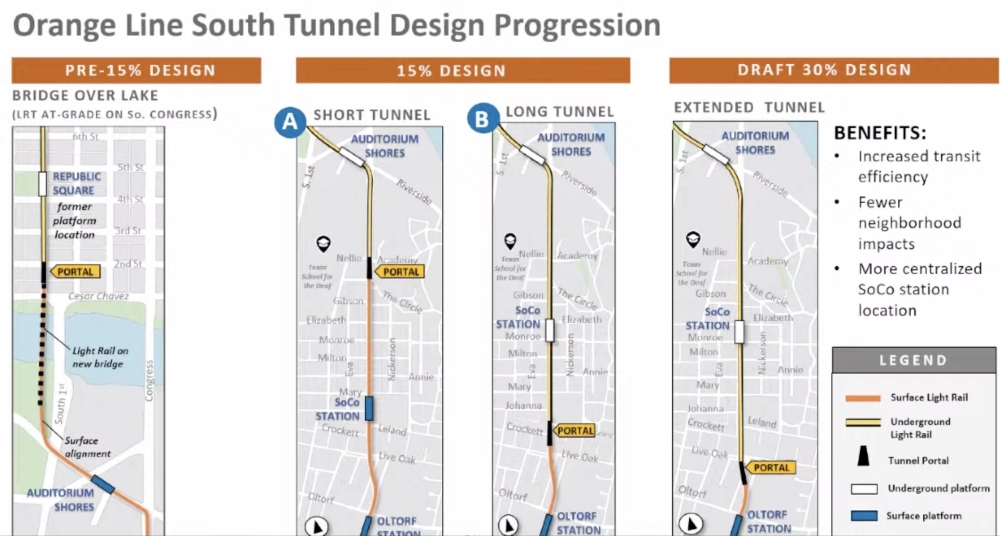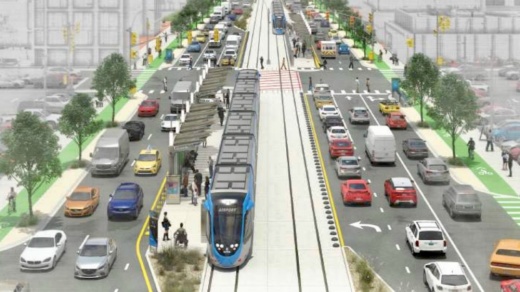Austin voters approved a $7.1 billion package for Project Connect in 2020 to expand the city's bus and rail network. Planning for the Orange and Blue light rail lines is on track to progress from the 15% to 30% design stages this summer, moving the final system outline closer to reality.
At the 5% design stage, estimates for the light rail lines totaled $5.8 billion: the Orange Line at $2.5 billion, the Blue Line at $1.3 billion and extensive tunnel work for both tracks at $2 billion. Now, heading into the 30% design phase, those figures have jumped more than 77% altogether to upward of $10.3 billion.
Transit officials said the $4.5 billion revision, including $600 million more for the Blue Line and around $2 billion each for the Orange Line and tunnel, has several causes. Among those is a "significant" increase in land acquisition costs along the proposed rail lines given Austin's hot real estate market and nationwide inflation that is driving up the construction budget.
"The Project Connect program is not immune to the global and national economic pressures that everyone is feeling. Transit, airport, highway, utility, housing, and commercial projects are all seeing cost increases," Project Connect Program Officer David Couch wrote in an April 7 memo. "Austin is experiencing these impacts at an even higher level than the national average due to the unprecedented growth we are experiencing." Despite the growing projections, however, Project Connect is not expected to cost city taxpayers more than they originally agreed to.
"As the cost estimates for the program change, there is no requirement to change the tax rate that funds the program. Instead, changes in program costs could result in adjustments to project phasing to balance funding of construction and operations of the system," said Blythe Nebeker, an Austin Transit Partnership communications specialist, in an email. "The Project Connect team remains fully committed to fulfilling the promise to build the program voters approved in November 2020."
Design updates
On top of external pressures, Couch said internal adjustments to Project Connect's scope have also contributed to the rising cost projections. For example, planners said during an early April workshop that a range of challenges along a stretch of the Orange Line could cause that single segment's costs to balloon more than 400%.
As initially envisioned, the new Orange Line would have run south from downtown and over Lady Bird Lake via a new bridge before continuing at surface level down South Congress Avenue. Instead, transit planners are now considering an extended tunnel under the lake that would rise above ground over 1 mile farther down Congress.
Planners said a bridge crossing is unfeasible due to a “spaghetti bowl” of utilities in the area, as well as development restrictions set through Capitol View Corridor limits. That city and state policy prohibits new construction that would affect sightlines to the capitol building downtown and would block the Orange Line outline as originally conceived.
The original bridge plan would have brought the Orange Line’s construction costs to $300 million-$350 million between Third Street downtown and Live Oak Street to the south. The extended tunnel option, moving the Orange Line below Lady Bird Lake and Congress before rising to street level at Live Oak, could now cost between $1.4 billion-$1.6 billion. According to the Project Connect team, the longest tunnel is the only available option for the Orange Line within the Capitol view confines.

Planners said the Capitol sight lines extend far enough down Congress to disqualify any other shorter tunnel options and an above-ground South Congress station. Even the longer tunnel's entrance portal and catenary poles were nearly in conflict with the state rules given the unforeseen limitations of the corridor restraints, which even extend several feet below ground near Live Oak.
“That was not something we expected when we were researching this and looking at state law and things like that. So that’s kind of what caused us to also take another look at that design for the portal, the stations and ultimately ended up with the extended tunnel,” said Sofia Ojeda, the Austin Transit Partnership's director of Orange Line design.
Finalized cost revisions for the proposed light rail lines can be expected when the new design stage is completed this summer.
"The 30% design cost estimates will bring a further refinement of the costs associated with real estate, inflation/supply chain, program progression and scope," Couch wrote.
Funding and feedback
Some new funding needs could in part be filled by federal contributions to Austin's large-scale transit initiative. Planners said in an April 7 memo that the federal share of Project Connect's Expo and Pleasant Valley MetroRapid bus lines is expected to jump more than 80% from $36.1 million to $65.6 million. Federal backing for the two light rail lines may also be coming down the road.
"CapMetro, the Austin Transit Partnership, and city of Austin continue to advance the Project Connect program. Thanks to our strong federal partnerships, the Orange and Blue light rail lines, and Expo and Pleasant Valley MetroRapid line federal processes are moving forward at the pace needed to meet our program delivery goals," planners wrote.
For now, city and transit officials are working to share project updates before the 30% design stage wraps up this summer. Council Members Chito Vela and Leslie Pool are holding a workshop April 11 to discuss mobility-related changes coming around Crestview Station. Transportation planners will also hold two Orange Line-specific meetings covering the latest on the track's southern and northern edges April 12 and 18, respectively.
"The Project Connect team is also committed to updating and involving the community on the implementation of the program and will continue to host public meetings, both virtually and in-person, to receive community feedback that could influence final program design decisions," Nebeker said.





